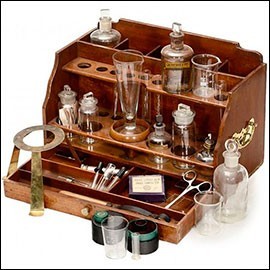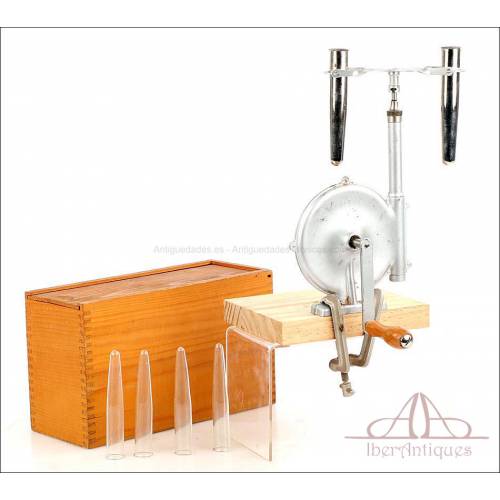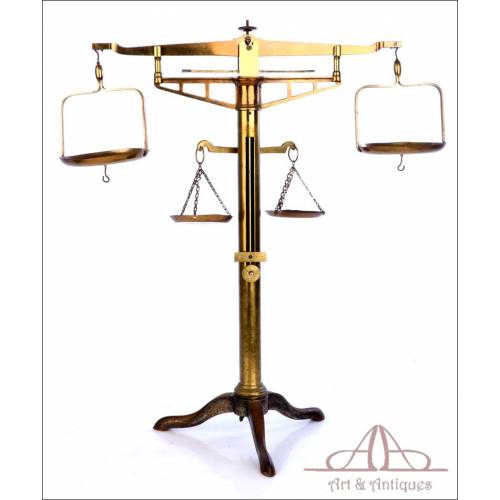Laboratory Antiques
From Alchemy to Physics
Alchemy, today regarded as a pseudo-scientific practice, is considered a precursor of modern science, both in terms of the procedures and the instruments used. Its presence extends over 2,500 years, from ancient Mesopotamia to 18th-century Europe, when it was disqualified as a science. A century earlier, in the 17th centu...
From Alchemy to Physics
Alchemy, today regarded as a pseudo-scientific practice, is considered a precursor of modern science, both in terms of the procedures and the instruments used. Its presence extends over 2,500 years, from ancient Mesopotamia to 18th-century Europe, when it was disqualified as a science. A century earlier, in the 17th century, with Galileo Galilei, modern science had been born and the laboratory instruments that were to serve the purposes of the scientific method had begun to be invented with the telescope and the binoculars.
Galileo, under Copernican inspiration, strengthened the practice of experimentation in science by collecting, measuring, observing, comparing and verifying variables and hypotheses. Francis Bacon and Johannes Kepler had pointed the way.
From inventions to antiquities
With the invention of the spectroscope in the early 19th century, Fraunhofer took the decisive step toward measuring the wavelength of light. The old spectroscope was used only to observe a spectrum. With the modern one, the spectrum to be observed is obtained. Other than that, there is no difference between the ancient spectroscope and today's spectroscope.
Still in the field of research on light, thanks to the invention of prisms by William Nicol was invented, still in the nineteenth century, the polarimeter, which uses polarized light to measure the rotational power of bodies. Unlike the old polarimeter, which was operated manually, today's polarimeter is capable of automatic measurements. The old polarimeter required manipulation time; today's polarimeter gives results in a second, thanks to the development of electricity and computer technologies.
The saccharimeter, another 19th century invention, shows the interest of physics in the search for precision. This apparatus, by which the proportion of sugar contained in a liquid is determined, reveals the service of science to industry. The sugar trade underwent an enormous expansion during this century. Also used in oenology, this Irish measuring instrument evolved from optical to digital use.
Intrinsic value of antiques
Link between History and Science, laboratory instruments are a sample of human creativity and ingenuity. The simplicity of the principles on which their invention is based and the magnitude of the results are surprising. The simple barometer invented by Torricelli in the mid-seventeenth century measured atmospheric pressure for the first time.
Over time, if they prevail, instruments so useful to human beings naturally become laboratory antiques and acquire a different value. They are now Antiques. Precious pieces for the collector, for the science lover and observer of history.
Precious pieces for the collector, for the science lover and observer of history.
Silent protagonists of their time, here are these laboratory antiques turned into witnesses, also silent, of other times that somehow were forged with their help. Hence the stimulus to acquire these pieces.
In addition to antique spectroscopes, antique polarimeters and antique saccharimeters, collectors who visit this page in search of laboratory antiques value apparatus for physical demonstrations and other apparatus for experimentation and science teaching. And, of course, the indispensable laboratory equipment, such as test tubes, test tubes, alcoholmeters, hydrometers, balances, beakers and others.
And, of course, the indispensable laboratory equipment, such as test tubes, test tubes, alcoholmeters, hydrometers, balances, beakers and others.
Antique Mechanical Laboratory Centrifuge. 1950s-60s Antique Mechanical Laboratory...
Fascinating mid 20th century mechanical laboratory centrifuge. Works very well. Includes 4 vintage test tubes. Fascinating mid 20th century...
SoldAntique Commerce Scale. Circa 1900 Antique Commerce Scale. Circa 1900
Gorgeous antique commerce scale in fine condition. More than one hundred years old. A very decorative piece. Gorgeous antique commerce scale in...
Sold
New products
-

Antique ivory and silver plated stethoscope, late 19th century
Antique stethoscope from the late 19th century in silver-plated metal...
-

Vintage pendant with shell cameo of Jesús del Gran Poder, carved c. 1970
Vintage pendant with a shell-carved cameo of Jesus del Gran Poder, circa...
-

Antique Roman Style Gilded Silver Chalice with Paten. France, 1932
Antique Roman-style chalice in gilded silver with paten. France, 1932....
-

Beautiful Antique 18 K Gold Ring with 7 Natural Diamonds
Antique 18K gold ring with 7 natural diamonds. Delicate openwork design,...
-

Antique Silver Reliquary. José Vilaplana. Valencia, Spain. Circa 1920
Impressive repoussé silver reliquary by José Vilaplana, Valencia, c....
-

Vintage 18K Gold Ring with 7 Natural Diamonds
Vintage 18K gold ring with seven natural diamonds in floral setting....
-

Antique Silver Chalice. Enameled Crosses. Valencia, Spain, 1942
Spanish chalice from 1942 in solid silver, gifted by the Church of...
-

Antique Silver Chalice and Paten. Granada Spain, circa 1900
Spanish chalice in white silver with matching paten, handcrafted....
Specials
-

Album with 12 Gramophone Discs. Classical Music. Original Album
Sevilla y Navarra, by I. Albéniz;...





